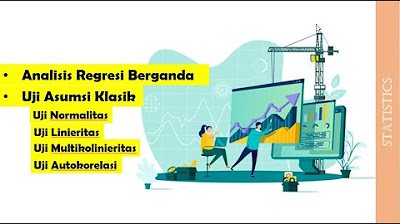SPSS (16): Testing the five assumptions of linear regression in SPSS
Summary
TLDRThis video explains how to assess key assumptions of a linear regression model using SPSS. It covers checking for linearity through scatter plots, verifying the expected mean error with residuals, and testing for homoscedasticity using graphical methods and the Breusch-Pagan test. The video also addresses autocorrelation with the Durbin-Watson test and evaluates the normality of residuals through descriptive tests and plots. By following these steps, viewers learn how to confirm if their regression model meets necessary assumptions for accurate analysis.
Takeaways
- 😀 Scatter plots are a simple way to check for linearity between the dependent and independent variables.
- 😀 When plotting scatter plots with binary variables, avoid using them as they don't show a clear linear relationship.
- 😀 A matrix scatter plot allows you to assess the relationships between multiple independent variables at once.
- 😀 When fitting a regression model, it's important to save residuals and predicted values for assumption testing.
- 😀 The expected mean error of the regression model should be zero, which can be checked by summing the residuals and predicted values.
- 😀 Homoscedasticity is checked by plotting residuals against predicted values; increasing or decreasing error variance indicates a problem.
- 😀 The Breusch-Pagan test is used to formally test for heteroscedasticity, and a p-value above 0.05 suggests homoscedasticity.
- 😀 The Durbin-Watson statistic is used to test for autocorrelation in residuals, but it's mainly relevant for time-series data.
- 😀 Normality of residuals can be assessed through visual plots (QQ plots) and statistical tests (Shapiro-Wilk or Kolmogorov-Smirnov).
- 😀 If the p-value from normality tests is above 0.05, residuals are considered normally distributed, satisfying a key regression assumption.
Q & A
What is the purpose of plotting the dependent variable against independent variables in scatter plots?
-The purpose of plotting the dependent variable against independent variables in scatter plots is to visually inspect if there is a linear relationship between them. This helps in checking the linearity assumption for the regression model.
Why is the binary variable 'store size' not useful in a scatter plot for testing linearity?
-The binary variable 'store size' is not useful in testing linearity because a binary variable only has two possible values, and a scatter plot won't reveal a meaningful linear trend. Scatter plots are more effective with continuous independent variables.
How can you check the linearity for multiple independent variables simultaneously?
-You can check the linearity for multiple independent variables simultaneously by using a matrix scatter plot. This creates a grid of scatter plots, allowing you to inspect the relationships between the dependent variable and each independent variable.
What does a decreasing trend in the scatter plot between sales and price suggest?
-A decreasing trend in the scatter plot between sales and price suggests a negative linear relationship, indicating that as the price increases, the sales tend to decrease.
What is the significance of adding a fitted line to a scatter plot?
-Adding a fitted line to a scatter plot helps visualize the linear relationship between the variables. It provides a clear indication of the direction (positive or negative) and strength of the relationship.
Why is it important to check if the expected mean error of the regression model is zero?
-It is important to check if the expected mean error of the regression model is zero because this ensures that the residuals, or errors, do not have a systematic bias. If the mean error is not zero, it could indicate issues with the model's fit or assumptions.
How is homoscedasticity tested visually, and what does it indicate?
-Homoscedasticity is tested visually by plotting the residuals against the predicted values. If the spread of residuals remains constant across all levels of the predicted values, it indicates homoscedasticity. If the spread increases or decreases, it indicates heteroscedasticity, which violates regression assumptions.
What is the Breusch-Pagan test, and how does it relate to homoscedasticity?
-The Breusch-Pagan test is a statistical test used to detect heteroscedasticity in a regression model. It tests whether the variance of the residuals changes with the independent variables. A significant result (p-value < 0.05) indicates heteroscedasticity.
What does a Durbin-Watson statistic close to 2 indicate, and when is it relevant?
-A Durbin-Watson statistic close to 2 indicates that there is no autocorrelation in the residuals. This is relevant in time series or panel data, where autocorrelation is a concern. For cross-sectional data, the Durbin-Watson test is not typically necessary.
How do you check for the normality of residuals, and what is the significance of the p-value in the normality test?
-You check for the normality of residuals by using normality plots, such as QQ plots or PP plots, and by performing statistical tests. The p-value in the normality test helps determine if the residuals follow a normal distribution. A p-value greater than 0.05 indicates that the residuals are normally distributed.
Outlines

Cette section est réservée aux utilisateurs payants. Améliorez votre compte pour accéder à cette section.
Améliorer maintenantMindmap

Cette section est réservée aux utilisateurs payants. Améliorez votre compte pour accéder à cette section.
Améliorer maintenantKeywords

Cette section est réservée aux utilisateurs payants. Améliorez votre compte pour accéder à cette section.
Améliorer maintenantHighlights

Cette section est réservée aux utilisateurs payants. Améliorez votre compte pour accéder à cette section.
Améliorer maintenantTranscripts

Cette section est réservée aux utilisateurs payants. Améliorez votre compte pour accéder à cette section.
Améliorer maintenantVoir Plus de Vidéos Connexes

Tutorial Uji Asumsi Klasik dengan SPSS serta Interpretasi Output

Regresi Linear Sederhana dengan Ordinary Least Square

COS10022 Linear Regression (Lecture)

(1/4) Analisis Regresi : Uji asumsi Klasik

Statistika: Uji Korelasi-Regresi sederhana menggunakan SPSS

Uji Regresi Linier Sederhana Dengan SPSS | Pembahasan Lengkap!
5.0 / 5 (0 votes)
